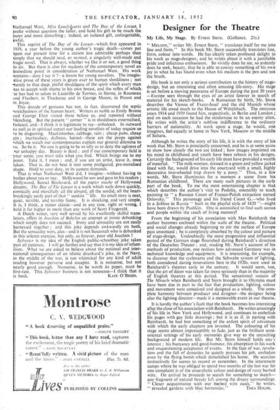Designer for the Theatre
My Life, My Stage. By Ernest Stern. (Gollancz. 21s.) " MELODY," writes Mr. Ernest Stem, " translates itself for me into line and form." In this book Mr. Stern successfully translates line, form, colour into words. He has clearly taken profound delight in his work as stage-designer, and he writes about it with a justifiable pride and infectious enthusiasm.- So vividly does he see, so ardently does he seek, beauty, that he is able to convey something of his own joy in what he has found even when hii medium is the pen and not the brush. • His book is not only a serious contribution to the history of stage- design, but an interesting and often amusing life-story. His stage is set before a moving panorama of Europe during the past 50 years —Europe seen through the eyes of an artist forever in search of material for his sketch-books. A Rumanian by birth, ' Mr. Stern describes the Vienna of Franz-Josef and the old Munich whose artistic life owed much to the House of Wittelsbach. The ominous years 1914 and 1939 found him, respectively, in Berlin and London ; and on each occasion he had the misfortune to be an enemy alien. He writes with the artist's sublime indifference to the ordinary barriers of nationality. At work upon a stage, he would, one imagines, feel equally at home in New York, Moscow or the middle of Sahara.
Although he writes the story of his life, it is with the story of his work that Mr. Stern is principally concerned, and he is at sorrie pains to show how closely the two are linked • how images imprinted on his mind in childhood and youth have been reborn in his designs. Certainly the background of his early life must have provided a wealth of material. "The milk-woman, dressed in a green and yellow jacket lined with fur, would drive into the courtyard with a small, highly decorative two-wheeled trap drawn by a pony." Thus, in a few words, Mr. Stein illuminates for a moment a scene from his Rumanian childhood. There are many such pictures in the early part of the book. To me the most entertaining chapter is that which describes the author's visit to Podolia, ostensibly to teach painting to " a Russian Count of Franco-Polish extraction named Orlovsky." This personage and his friend Count G.—who lived in a Schloss in Russia " built in the playful style of 1820 "—might have been drawn by Pushkin. One is astonished, to find such scenes and people within the leach of living memory!
From the beginning of his association with Max Reinhardt the author becomes enclosed within the walls of the theatre. Political and social changes already beginning to stir the surface of Europe pass unnoticed ; he is completely absorbed by thecolour and pattern of stage-design. Undoubtedly the most progressive and influential period of the German stage flourished during Reinhardt's direction of the Deutsches Theater ; and, reading Mr. Stern's account of his methods of production, one realises how advanced Germany was in technical knowledge and equipment. It is interesting, for example, to discover that the cyclorama and the Schwabe system of lighting, both considered daring innovations here in the 1920s, were used in Reinhardt's theatres early in the century. It would seem, too, that the art of decor was taken far more seriously than in the majority of English theatres at this period. The sensational success of The Miracle when Reinhardt and Stern brought it to Olympia must have been due in part to the fact that production, lighting, colour and movement were conceived and designed as a whole. The com- plete harmony between producer and designer—the designer being also the lighting director—made it a memorable event in our theatre.
It is hardly the author's fault that the book becomes less interesting after the close of his association with Reinhardt. He writes amusingly of his life in New York and Hollywood, and continues to embellish his pages with gay little drawings ; but it is as if in parting with Reinhardt, he had lost something of the ardent spirit of adventure with which the early chapters are invested. The colouring of his stage seems almost imperceptibly to fade, just as the brilliant semi- oriental settings of his early memories give way to the unexciting background of modern life. But Mr. Stern himself holds one's interest ; his buoyancy and good-humour, his absorption in his work and unquestioning acceptance of events. In the face of war, revolu- tion and the fall of dynasties he quietly pursues his job, unshaken even by the flying bomb, which demolished his home. He searches instinctively for scenes to record or remember. In the internment camps where he was obliged to spend two months of the last war his one complaint is of the unaesthetic colour and design of rusty barbed wire. On arrival he proceeds to search for something to sketch— any fragment of natural beauty left among the dreary surroundings. " Closer acquaintance with our barbed wire oasis," he writes, " revealed gardens with blue hortensias." THEA HOLIVIE.


































 Previous page
Previous page